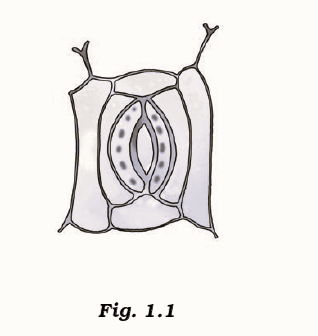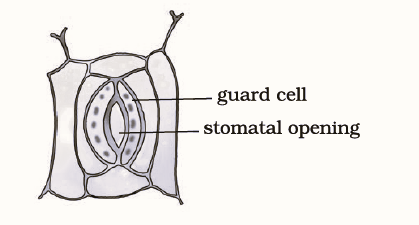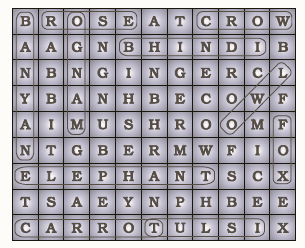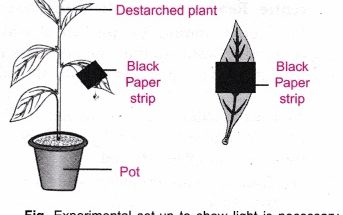Chapter 1 Nutrition In Plants – Concepts included in the chapter –
- Autotrophic Nutrition: Understanding how plants produce their own food through photosynthesis, using sunlight, carbon dioxide, and water.
- Heterotrophic Nutrition: Learning about plants that do not produce their own food and depend on other organisms, including parasitic and saprotrophic nutrition.
- Soil Nutrient Replenishment: Studying how nutrients are cycled back into the soil, including the role of nitrogen-fixing bacteria.
Also Check – Rapid Revision – Class 7 Science -Chapter 1- Nutrition in Plants – Complete Notes
NCERT Exemplar – Class 7 Science- Chapter 1 – Nutrition In Plants- Solved
Question 1 – Organisms which prepare food for themselves using simple naturally available raw materials are referred to as-
- (a) heterotrophs
- (b) autotrophs
- (c) parasites
- (d) saprophytes
Answer- (b) autotrophs.
Explanation- Autotrophs are organisms that can produce their own food using light, water, carbon dioxide, or other chemicals. Green plants are common examples of autotrophs that use photosynthesis.
Question 2- In the absence of which of the following will photosynthesis not occur in leaves?
- (a) Guard cells
- (b) Chlorophyll
- (c) Vacuole
- (d) Space between cells
Answer- (b) Chlorophyll.
Explanation- Chlorophyll is the green pigment in leaves that captures light energy necessary for photosynthesis. Without chlorophyll, the plant cannot absorb the required light energy to carry out photosynthesis.
Also Check – Chapter 1- Nutrition in Plants -Class 7 – Detailed Notes
Question 3- Which of the following statements is/are correct?
- (i) All green plants can prepare their own food.
- (ii) Most animals are autotrophs.
- (iii) Carbon dioxide is not required for photosynthesis.
- (iv) Oxygen is liberated during photosynthesis.
Choose the correct answer from the options below-
- (a) (i) and (iv)
- (b) (ii) only
- (c) (ii) and (iii)
- (d) (i) and (ii)
Answer- (a) (i) and (iv).
Explanation- All green plants can prepare their own food through photosynthesis (i), and oxygen is a by-product of this process (iv). Animals are heterotrophs (not autotrophs), and carbon dioxide is a necessary reactant in photosynthesis.
Also Check – Nutrition in Plants – Class 7 Questions with Answers Worksheet
Question 4 – Pitcher plant traps insects because it-
- (a) is a heterotroph.
- (b) grows in soils which lack nitrogen.
- (c) does not have chlorophyll.
- (d) has a digestive system like human beings.
Answer- (b) grows in soils which lack nitrogen.
Explanation- Pitcher plants are carnivorous and have adapted to trap and digest insects to supplement their nitrogen requirements. They generally grow in nutrient-poor soils, where nitrogen is a limiting factor.
Also Check – Class 7- Chapter 1 – Nutrition in Plants – 4 Worksheets Solved and Unsolved
Question 5 – The term that is used for the mode of nutrition in yeast, mushroom, and bread-mould is-
- (a) autotrophic
- (b) insectivorous
- (c) saprophytic
- (d) parasitic
Answer- (c) saprophytic.
Explanation- Yeast, mushrooms, and bread-mould are types of fungi. They exhibit saprophytic nutrition, which involves absorbing nutrients from dead and decaying organic matter.
Question 6 – When we observe the lower surface of a leaf through a magnifying lens, we see numerous small openings. Which of the following is the term given to such openings?
- (a) Stomata
- (b) Lamina
- (c) Midrib
- (d) Veins
Answer- (a) Stomata.
Explanation- Stomata are small openings usually found on the underside of leaves. They play a crucial role in gas exchange, allowing carbon dioxide to enter and oxygen to exit during the process of photosynthesis.
Also Check – Class 7 Science -Chapter 1- Nutrition in Plants- Definition and Explanation of Important Keywords
Question 7 – Two organisms are good friends and live together. One provides shelter, water, and nutrients while the other prepares and provides food. Such an association of organisms is termed as-
- (a) saprophyte
- (b) parasite
- (c) autotroph
- (d) symbiosis
Answer- (d) symbiosis.
Explanation- Symbiosis is a close and long-term biological interaction between two different biological organisms. In this type of relationship, both organisms benefit from the association.
Question 8 – Which of the following raw materials is available in the air for photosynthesis?
- (a) Oxygen
- (b) Carbon dioxide
- (c) Nitrogen
- (d) Hydrogen
Answer- (b) Carbon dioxide.
Explanation- Carbon dioxide is a crucial raw material for photosynthesis. It is absorbed from the air and used along with water to produce glucose and oxygen.
Question 9 – Potatoes and ginger are both underground parts that store food. Where is the food prepared in these plants?
Answer- In these plants, the food is prepared in the leaves, which are above ground. The leaves perform photosynthesis to prepare food, which is then stored in the underground parts like potato and ginger.
Photosynthesis requires chlorophyll, and a few other raw materials. Add the missing raw materials to the list given below- Water, minerals, _____________, ______________.
Answer- Sunlight/light energy, Carbon dioxide.
Explanation- Photosynthesis requires sunlight (or light energy) and carbon dioxide, in addition to water and minerals, to produce glucose and oxygen.
Question 10 – A goat eats away all the leaves of a small plant (balsam). However, in a few days, new leaves could be seen sprouting in the plant again. How did the plant survive without leaves?
Answer- The plant survived without leaves by using stored food in its stems and roots. Plants store food in various parts, which can be used for growth and survival when necessary.
Question 11- Unscramble the following to form terms related to modes of nutrition-
- (i) RASPAEIT
- (ii) ROPEHYTSAP
- (iii) TOROPHAUT
- (iv) SIBIOMSYS
Answer-
- (i) PARASITE
- (ii) SAPROPHYTE
- (iii) AUTOTROPH
- (iv) SYMBIOSIS
Question 12 – Nitrogen is an essential nutrient for plant growth. But farmers who cultivate pulse crops like green gram, bengal gram, black gram, etc., do not apply nitrogenous fertilisers during cultivation. Why?
Answer- Pulse crops have a symbiotic relationship with nitrogen-fixing bacteria in their root nodules. These bacteria, such as Rhizobium, can fix atmospheric nitrogen, converting it into a form that the plants can use. Therefore, farmers do not need to apply nitrogenous fertilisers for these crops.
Question 13 – Wheat dough, if left in the open, after a few days, starts to emit a foul smell and becomes unfit for use. Give a reason.
Answer- When wheat dough is left in the open, it gets contaminated with microorganisms like yeast and bacteria. These organisms feed on the carbohydrates present in the dough and produce gases and other compounds during their metabolic activities, which cause the dough to emit a foul smell and become unfit for use.
Question14 – Sunlight, chlorophyll, carbon dioxide, water, and minerals are raw materials essential for photosynthesis. Do you know where they are available? Fill in the blanks with the appropriate raw materials.
- (a) Available in the plant- Chlorophyll
- (b) Available in the soil- Water, Minerals
- (c) Available in the air- Carbon dioxide
- (d) Available during the day- Sunlight
Question 15 Observe the diagram given as Figure 1.1 and label the following terms given in the box.

Answer-

Question 16- Match the organisms given in Column I with their mode of nutrition given in Column II.
| Column I | Column II |
| a) Mango tree | i) Insectivorous plant |
| b) Mushroom | ii) Heterotroph |
| c) Pitcher Plant | iii) Autotroph |
| d) Cuscuta | iv) Saprophyte |
| e) Elephant | v) Parasitic |
Answer-
- a) Mango tree – iii) Autotroph
- b) Mushroom – iv) Saprophyte
- c) Pitcher Plant – i) Insectivorous plant
- d) Cuscuta – v) Parasitic
- e) Elephant – ii) Heterotroph
Explanation-
- Mango tree (Autotroph) prepares its own food using sunlight, water, and carbon dioxide through the process of photosynthesis.
- Mushrooms (Saprophyte) obtain nutrients by breaking down dead and decaying organic matter.
- Pitcher Plant (Insectivorous) supplements its nutrition by trapping and digesting insects.
- Cuscuta (Parasitic) is a parasitic plant that derives nutrients from other living plants.
- Elephants (Heterotroph) are animals that cannot produce their own food and rely on other organisms, mainly plants, for their nutrition.
Question 17 – Wild animals like tiger, wolf, lion, and leopard do not eat plants. Does this mean that they can survive without plants? Provide a suitable explanation.
Answer- No, these wild animals cannot survive without plants. Although they are carnivores and do not directly consume plants, they depend on herbivores for food. Herbivores eat plants, and by consuming herbivores, carnivores indirectly depend on plants for their survival. Plants form the basis of the food chain, and their absence would affect the entire ecosystem, including carnivores.
Question 18 – Fill in the blanks of the paragraph given below with the words provided in the box- chlorophyll, energy, food, carbon dioxide, water, photosynthesis. Note- A word can be used more than once.
- “Leaves have a green pigment called (a) _________ which captures (b) _________ from sunlight. This (c) _________ is used in the process of (d) _________ and along with other raw materials like (e) _________ and (f) _________ synthesise (g) _________.”
Answer-
- (a) chlorophyll
- (b) energy
- (c) energy
- (d) photosynthesis
- (e) water
- (f) carbon dioxide
- (g) food
Explanation- Chlorophyll in leaves captures energy from sunlight, which is then used in the photosynthesis process. During photosynthesis, plants use carbon dioxide and water to synthesise food.
Question 19 -Spot as many organisms as possible in the puzzle given in Figure 1.2 by encircling them as shown. Write the names on a sheet of paper and categorise them into autotrophs and heterotrophs. Classify the heterotrophs into herbivores, carnivores, omnivores, and saprophytes.

Answer-
- Autotrophs- Rose, Mango, Bhindi, Carrot, Banyan, Tulsi, Ginger, Yam
- Heterotrophs- Elephant, Ant, Yeast, Tiger, Mushroom, Fox, Mice, Owl, Cow, Crow, Rabbit, Bee, Fish
- Herbivores- Elephant, Cow, Rabbit, Bee
- Carnivores- Fox, Tiger
- Omnivores- Ant, Mice, Owl, Crow, Fish
- Saprophytes- Mushroom, Yeast
Question 20 – Can you give me a name? Solve each of the following riddles by writing the name of the organism and its mode of nutrition. One riddle is solved to help you.
- (a) I am tall but I cannot move. I am green and can prepare my own food. – tree, autotroph
- (b) I live in water; people keep me in an aquarium and feed me.– fish, heterotroph
- (c) I am small and I can fly. I disturb your sleep, bite you and suck your blood which is my food. – mosquito, parasite
- (d) I am white and soft. I grow well in the rainy season. Children pluck me from the ground and admire me. I absorb nutrients from decomposed dead parts of plants and animals in the soil. – mushroom, saprophyte
Also Check – NCERT Solutions for Class 7 Science Chapter 1: Nutrition In Plants
